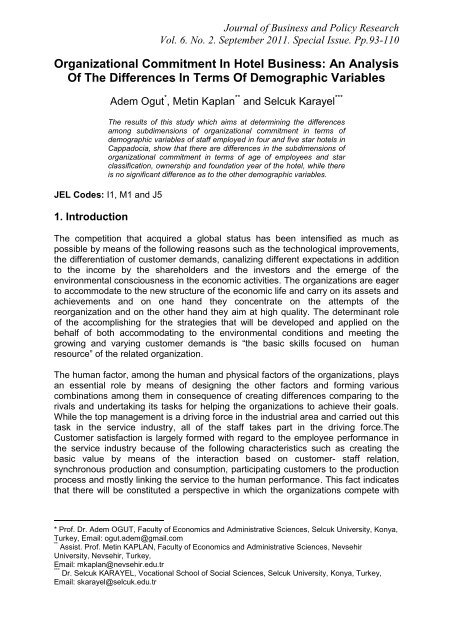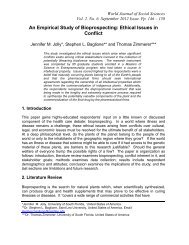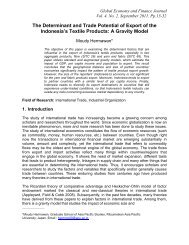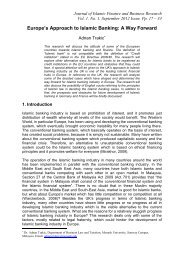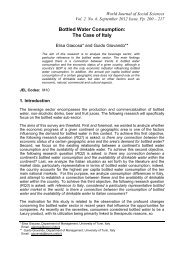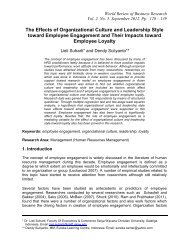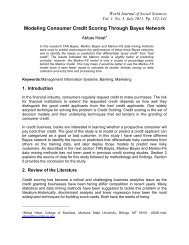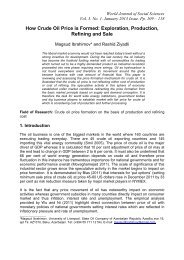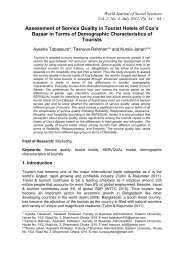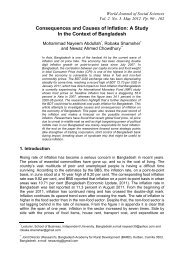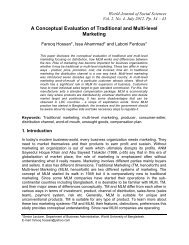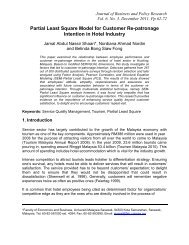Organizational Commitment In Hotel Business - Wbiaus.org
Organizational Commitment In Hotel Business - Wbiaus.org
Organizational Commitment In Hotel Business - Wbiaus.org
You also want an ePaper? Increase the reach of your titles
YUMPU automatically turns print PDFs into web optimized ePapers that Google loves.
Journal of <strong>Business</strong> and Policy ResearchVol. 6. No. 2. September 2011. Special Issue. Pp.93-110<strong>Organizational</strong> <strong>Commitment</strong> <strong>In</strong> <strong>Hotel</strong> <strong>Business</strong>: An AnalysisOf The Differences <strong>In</strong> Terms Of Demographic VariablesAdem Ogut * , Metin Kaplan ** and Selcuk Karayel ***The results of this study which aims at determining the differencesamong subdimensions of <strong>org</strong>anizational commitment in terms ofdemographic variables of staff employed in four and five star hotels inCappadocia, show that there are differences in the subdimensions of<strong>org</strong>anizational commitment in terms of age of employees and starclassification, ownership and foundation year of the hotel, while thereis no significant difference as to the other demographic variables.JEL Codes: I1, M1 and J51. <strong>In</strong>troductionThe competition that acquired a global status has been intensified as much aspossible by means of the following reasons such as the technological improvements,the differentiation of customer demands, canalizing different expectations in additionto the income by the shareholders and the investors and the emerge of theenvironmental consciousness in the economic activities. The <strong>org</strong>anizations are eagerto accommodate to the new structure of the economic life and carry on its assets andachievements and on one hand they concentrate on the attempts of there<strong>org</strong>anization and on the other hand they aim at high quality. The determinant roleof the accomplishing for the strategies that will be developed and applied on thebehalf of both accommodating to the environmental conditions and meeting thegrowing and varying customer demands is “the basic skills focused on humanresource” of the related <strong>org</strong>anization.The human factor, among the human and physical factors of the <strong>org</strong>anizations, playsan essential role by means of designing the other factors and forming variouscombinations among them in consequence of creating differences comparing to therivals and undertaking its tasks for helping the <strong>org</strong>anizations to achieve their goals.While the top management is a driving force in the industrial area and carried out thistask in the service industry, all of the staff takes part in the driving force.TheCustomer satisfaction is largely formed with regard to the employee performance inthe service industry because of the following characteristics such as creating thebasic value by means of the interaction based on customer- staff relation,synchronous production and consumption, participating customers to the productionprocess and mostly linking the service to the human performance. This fact indicatesthat there will be constituted a perspective in which the <strong>org</strong>anizations compete with* Prof. Dr. Adem OGUT, Faculty of Economics and Administrative Sciences, Selcuk University, Konya,Turkey, Email: ogut.adem@gmail.com** Assist. Prof. Metin KAPLAN, Faculty of Economics and Administrative Sciences, NevsehirUniversity, Nevsehir, Turkey,Email: mkaplan@nevsehir.edu.tr*** Dr. Selcuk KARAYEL, Vocational School of Social Sciences, Selcuk University, Konya, Turkey,Email: skarayel@selcuk.edu.tr
Ogut, Kaplan & Karayeleach other for the qualified workforce who has the ability of creating difference anddevelopment among the companies.<strong>In</strong> parallel with these developments, Human Resource management effectiveness forthe <strong>org</strong>anizations recently has become a principal intended action and main purposeof them such as providing services and producing items. <strong>Organizational</strong>commitment has been stood out while carrying out this goal. <strong>Organizational</strong>commitment is a significant fact for the staff to adopt the aims and objectives,continue their demand to remain in the <strong>org</strong>anization, participate to the <strong>org</strong>anizationmanagement and activities and carry out innovative and creative attitudes. Thegrowth of demand for the educated and the competent workforce for the<strong>org</strong>anizations and the inadequacies of the qualified labour supply, bring forward thestaff transfer. Consequently, it becomes difficult to retain the qualified staff for the<strong>org</strong>anizations. The leaving of the well-trained and acculturated staff bring alongmixed costs. <strong>In</strong> this context, increasing the <strong>org</strong>anizational commitment of theemployees, determining the antecedents to retain them and revealing how theseantecedents differentiated have been emerged as a significant study field.The aim of the study in consideration of these evaluations; revealing whether thestaff employed in four and five star hotels in Cappadocia has the significantdifferences among the subdimensions of the <strong>org</strong>anizational commitment in terms ofdemographic variables or not. Also, It is expected that the results of the study willcontribute to the directors of the <strong>org</strong>anizations, principally responsible for providingthe <strong>org</strong>anizational effectiveness and productivity, to consider the differencesgenerated from the demographic variables of the staff without leaving the prevalenthuman resource policies and sense of justice during the process of creating andimproving the process of the <strong>org</strong>anizational commitment.<strong>Organizational</strong> <strong>Commitment</strong>; besides willingness to remain in the <strong>org</strong>anization (Ferrisand Aranya 1983), is the participation of an individual to an <strong>org</strong>anization andidentification with the <strong>org</strong>anization (Becker 1992). From an exchange perspective,commitment is a sense of support for and from the <strong>org</strong>anization (Mize, Stanforth andJohnson 2000). The concept of the <strong>org</strong>anizational <strong>Commitment</strong> involves the followingthree factors (Maxwell and Steele 2003); -Acceptance of the <strong>org</strong>anizational aims andvalues and a strong belief to these aims, -the willingness of the struggles to reach the<strong>org</strong>anizational aims and –having a strong desire for carrying on the <strong>org</strong>anizationalmembership. İbicioğlu (2000) has added the identification with the <strong>org</strong>anizationidentity and internalization to these elements. Although, there have been variousclassifications in literature concerning the <strong>org</strong>anizational commitment, this studybased on the affective, normative and continuance commitment of Meyer and Allen(1997).Affective commitment covers the identification with the <strong>org</strong>anization and thefeelings for the <strong>org</strong>anization besides the pleasure of being a membership of the<strong>org</strong>anization (Bergaman 2006). <strong>In</strong> other words, affective commitment means devotionof the employees to their foundation, identification with their foundation andembracing the aims and the objectives of the foundation and be proud of theirfoundation (Bulut et al. 2009).94
Ogut, Kaplan & KarayelNormative commitment is a sense of obligation of an individual or it reflects theresponsibility of the commitment and remaining within the <strong>org</strong>anization (Asa andDalkılıç 2008). <strong>In</strong> normative commitment, the individual feels indebted to the<strong>org</strong>anization. The training activities of the <strong>org</strong>anization and the good relations withthe <strong>org</strong>anization, feeling indebted himself to the <strong>org</strong>anization and continue his labourbased on appreciation are the elements of the normative commitment (Yıldırım andDemirel 2009).Continuance commitment refers to requirement level to remain in the <strong>org</strong>anizationbecause of the costs depend on the investments (benefit, advantage, self-interest) ofthe individual for the <strong>org</strong>anization. Continuance commitment is a desire to belong tothe <strong>org</strong>anization. Continuance commitment depends on the belief that leaving the<strong>org</strong>anization costs much. Normative commitment is the feeling an obligation for the<strong>org</strong>anization (Bergaman 2006). <strong>In</strong> this context, the affective commitment includes adesire, normative commitment includes an obligation and continuance commitmentincludes a requirement (Yozgat and Şişman 2007).The antecedents of the <strong>org</strong>anizational commitment are considerably varied in theirroot and nature. The authors classified the factors that affect the <strong>Organizational</strong><strong>Commitment</strong> in various forms.Steers (1977), has analyzed the relations between the personal characteristics, jobspecifications, work experiences and the <strong>org</strong>anizational commitment. Luthans, Baackand Taylor (1987), has classified the antecedents of the <strong>org</strong>anizational commitmentin their suggested model into three groups; individual-demographic variables,<strong>org</strong>anizational relations and harmony of the individual-<strong>org</strong>anization. Glisson andDurick (1988) has classified the determinants of the <strong>org</strong>anizational commitment asindividual characteristics, profession-task characteristics and <strong>org</strong>anizationalcharacteristics. Similarly, Meyer and Allen (1991), has classified the antecedents ofthe <strong>org</strong>anizational commitment as individual characteristics, structural characteristics,work- linked characteristics and work experiences. There are also studies underliningthe specific characteristics of the commitment for various extents. For example, whilerationalizations, meeting the expectations, individual and job harmony, requirementof the satisfaction are particularly important to improve the affective commitment, onthe other hand they don‟t make way for the continuance and normative commitment(Mowday 1998). Also Harrison and Hubbard (1998) has classified the antecedents ofthe <strong>org</strong>anizational commitment into two groups; individual and situational factors.Kaçmar, Carlson and Brymer (1999) has classified the antecedents of the<strong>org</strong>anizational commitment as demographic characteristics, leader-memberexchange and justice of distribution. On the other hand, Zangaro (2001) hasclassified the antecedents of the <strong>org</strong>anizational commitment as individualcharacteristics, work experiences and work characteristics.Meyer et al. (2002), has classified the factors that affect the commitments: individualcharacteristics and work experiences for the affective commitment; individualcharacteristics and alternatives and investments for continuance commitment;individual characteristics, the experiences of the socialization and <strong>org</strong>anizationalinvestments for normative commitment.Maxwell and Steele (2003) have classified the significant antecedents of the<strong>org</strong>anizational commitment into four groups; individual characteristics, characteristics95
Ogut, Kaplan & Karayelregarding the job and the role, work experiences and structural characteristics.Similarly, Özdevecioğlu (2003), has classified the factors that determine the level of<strong>org</strong>anizational commitment; individual factors, the factors regarding the job and therole, the factors regarding the work experiences and the work environment, thefactors regarding the <strong>org</strong>anizational structure.The individual factors are stated as a common factor by many researchers above thelines. The individual factors are critically important to internalize the <strong>org</strong>anizationalobjectives and values and sustainability of the <strong>org</strong>anizational objectives and values inthe <strong>org</strong>anization for a long time. The individual factors cover the job expectancypsychological aggrement and demographic characteristics (Steers 1977, Luthans,Baack and Taylor 1987, Cohen 1992, Suliman 2002, Ahmad and Bakar 2003, Al-Qarioti and Al-Enezi 2004, Durna and Eren 2005, Mclnnis, Meyer and Feldman2009).<strong>In</strong> our study, among the individual factors that affect the <strong>org</strong>anizational commitment,the demographic characteristics are chosen as an independent variable. The age,education, gender, marital status and seniority of the individual are regarded as thedemographic characteristics (Zangaro 2001). It has been revealed that manydemographic characteristics are related to the <strong>org</strong>anizational commitment. The age,as a variable is the positive determining factor of the <strong>org</strong>anizational commitment. Asthe age of the employee passes, generally the decreasing of the alternative joboptions makes their current positions attractive. <strong>In</strong> addition to this, the olderindividuals‟ commitment is higher than the young individuals as they have much moreinvestments and past (Luthans, Baack and Taylor 1987, Glisson and Durick 1988).On the other hand, the studies concerning the relations between the <strong>org</strong>anizationalcommitment and the gender have revealed conradictional results. While someresearchers stated that the women had more affective commitment, the otherresearchers asserted that this relation based on a negative direction (Al-Qarioti andAl-Enezi 2004). Generally, the commitments of the women to the <strong>org</strong>anizations arehigher than the gentleman. This fact indicates that the women had to face muchmore difficulties than the gentleman for being a membership (Kaçmar, Carlson andBrymer 1999). Also it has been revealed that the marital status is related with thecommitment. The married couples display much more commitment to the<strong>org</strong>anizations. This correlation can be expected because the married couples takeover the responsibility of the financial burden and the family and need for much moreconfidence and stability in comparison with the singles and consequently the marriedones commitment is higher than the single ones (Kaçmar, Carlson and Brymer 1999,Chughtai and Zafar 2006). The relations between the <strong>org</strong>anizational commitment andthe education level have been analyzed and then it is stated that the commitmentsof the employees with a higher education level are lower than the others. The mainfactor of this result is based on the difficulties faced by the employees with a lowereducation level (Chughtai and Zafar 2006), on the other hand the employees with ahigher education level can find a job easily and consequently they less adapt to their<strong>org</strong>anizations (Özkaya, Kocakoç and Kara 2006). It has been stated that seniority isalso one of the determinant of the <strong>org</strong>anizational commitment. The high rankingmembers and the senior members display much more commitment to the<strong>org</strong>anizations (Luthans, Baack and Taylor 1987, Glisson and Durick 1988, Ahmadand Bakar 2003). Although it has been stated that there has been a relation betweenthe field research, <strong>org</strong>anizational commitment and seniority, it is not obvious that howit works (Chughtai and Zafar 2006).96
Ogut, Kaplan & Karayel2. Literature ReviewThe results of the research analyzing the relations between the demographiccharacteristics and the <strong>org</strong>anizational commitment presented below. Luthans, Baackand Taylor (1987), have classified the demographic characteristics as age,education, seniority at the <strong>org</strong>anization, current seniority, time passed with thecurrent manager and then stated that there has been a positive relationship betweenthe <strong>org</strong>anizational commitment and the demographic characteristics in the researchthat covers 406 employees working in the small and big business administrations ofmanufacture, service, finance, health and education. On the other hand, Cohen(1992), has revealed that there is no meaningful variation in the relation that coversage and the <strong>org</strong>anizational commitment among the occupational clusters in his studyregarding the the <strong>org</strong>anizational commitment between the white collar employeesand the blue collar employees. It hasn‟t been found out that there are meaningfulrelationships between the the white collar employees and the blue collar employeesfor seniority variables. It has been found out that there are meaningful relationshipsbetween the professional employees and the non- professional employees. Similarly,it has been revealed that the negative relationship between the <strong>org</strong>anizationalcommitment and the education is meaningfully stronger in the blue collar employeesin comparison with the white collar employees. That is, the less educated blue collaremployees display much more commitment to the <strong>org</strong>anizations than the moreeducated white collar employees. <strong>In</strong> the sense of gender, the women of the bluecollar employees display much more commitment to the <strong>org</strong>anizations and on theother hand, the men of the white collar professionals display much more commitmentto the <strong>org</strong>anizations. The relationship between the marital status and the<strong>org</strong>anizational commitment is stronger in the blue collar employees in comparisonwith the white collar employees. Being married is an important relation in terms of thewhite collar employees in comparison with the blue collar employees for the<strong>org</strong>anizational commitment. <strong>In</strong> terms of the number of children, there is nomeaningful variables between the the white collar employees and the blue collaremployees. Chang (2002) has found out that the men display much morecommitment to the <strong>org</strong>anizations than the women in a research carried out in serviceand manufacturing sector in Korea. Also another finding stated that the older onesand the ones whose working time is long display high fidelity to the <strong>org</strong>anizations.Durna and Eren (2005) has revealed that there is a positive relationship between theage of the employees who devoted themselves to the <strong>org</strong>anizations as affective andnormative commitments in a research carried out in Niğde, a province of Turkey,covers 300 people composed of teachers, doctors and nurses. They have found outthat there is no relation between the gender and the subdimensions of the<strong>org</strong>anizational commitment. <strong>In</strong> terms of seniority variables, they have found out thefollowing findings: a partial association based on a positive direction between theaffective commitment and seniority, a strong association based on a positivedirection between the seniority and the normative and <strong>org</strong>anizational commitment. <strong>In</strong>terms of marital status, the research results indicates that a strong associationbetween the marital status of the employees and the normative and <strong>org</strong>anizationalcommitment, a slight association with the affective commitment, a strong associationbetween the marital status and the continuance commitment. Chughtai and Zafar(2006) have carried out a research in Pakistan covering the full time academiciansand couldn‟t find out a meaningful relation between the age, seniority, marital status,education level and the <strong>org</strong>anizational commitment. Özkaya, Kocakoç and Kara(2006), have revealed the following results; the continuance commitment will97
Ogut, Kaplan & Karayelincrease as the age passes, the continuance commitment of the women is higherthan the men, the normative and continuance commitment of the high-schoolgraduates are higher than the university and MA graduates, the affective and thenormative commitment of the married ones are higher than the singles. <strong>In</strong> contrastwith these findings, in a research carried out in Adana, a province of Turkey,regarding the factors that affect the <strong>org</strong>anizational commitment of the employee ofthe A Class Travel Agencies, Yalçın and İplik (2007), have found out that the<strong>org</strong>anizational commitment will decrease, as the age of the travel agencies‟employees passes, the <strong>org</strong>anizational commitment will increase as the educationlevel getting higher and the <strong>org</strong>anizational commitment will decrease as the totalemployment getting longer3. MethodologyThe sample of the research covers the employee of the 4 and 5 star hotels (Fifteen 4star hotels and Five 5 star hotels) with Tourism Operation Licence. “The Complete<strong>In</strong>ventory Method”, identified as the observing (Serper and Aytaç 2000) all of theunits of the community in which the survey is carried out for obtaining information istaken as a basic method. <strong>In</strong> order to state the sampling frame, the individualinterviews with the senior officials of the aforesaid hotels have been carried out andthe total number of the staff has explained as 967. <strong>In</strong> this context, the survey formhas been sent to all of the units of the sampling frame. The number of the returnedsurvey is 418. But five of them didn‟t include to the assessment process. The numberof evaluated survey is 413. The rate of return of the surveys is 43.0 %. This rate is anacceptable one for these researches in the scientific world (Pierce and Henry 1996).The survey has been used as a data collection method in the research. The scalecomposed by Meyer and Allen (1997) has been used. The scale of the <strong>org</strong>anizationalcommitment covers 3 dimensions and 20 statements such as the affectivecommitment (6 items), the normative commitment (6 items) and the continuancecommitment (8 items). 5 point likert scale has been used (1=strongly disagree, 5=strongly agree). Cronbach's Alpha Coefficient; the affective commitment: 0,88, thenormative commitment: 0,78 and the continuance commitment: 0.86. There is noremoved proposal as we couldn‟t find a proposal whose reliability is highly low.<strong>In</strong> the second part of the survey, there are questions related with the age, maritalstatus, education level, whether taking the vocational tourism education or not,employment period, position in the hotel, department of the participants besides thequestions related with the hotel such as how many stars does the hotel have, theownership position of the hotel and the age of the hotel.The “t” test and “ANOVA” tests have been used for examining the variables in linewith the research objectives.4. Findings and Conclusion4.1 The Characteristics of the SamplingThe demographic characteristics of the employees evaluated in the context of theresearch given in Table 1.98
Ogut, Kaplan & KarayelTable 1: The Demographic Characteristics of the Employees Participating tothe SurveyCharacteristics f % Characteristics f %GenderMaleFemale30011372,627,4Marital StatusMarriedSingle24716659,840,2Age25 and younger26-35 age range36-45 age range46-55 age rangeTaking TourismVocational EducationYesNoThe Position of theEmployeeDepartmant ManagerChefWorkern= 4131261957616205208206033330,547,218,43,949,650,44,814,580,7Education LevelPrimary SchoolH. School and EquivalentsTwo-year degreeBachelor's degreePostgraduateThe Employment Period inthe Aforesaid <strong>Hotel</strong>sLess than 1 year1-3 years range4-6 years range7-9 years range10 years and over912216335310415074335222,053,515,38,50,725,236,317,98,012,6The research results covering the demographic characteristics of the employees inTable 1; 72,6% of the participants are male, 27,4% of the participants are female. <strong>In</strong>terms of marital status 59,8% are married and 40,2% are single. The age range ofthe employees are 30,5% are 25 age and younger; 47, 2% are in the range of 26-35;18, 4% are in the range of 36-45 and 3,9 % are in the range of 46-55. The educationlevels of the employees who participated to the survey are stated in the followingfigures: 22% Primary school, 53,5% High School and Its equivalents, 15,3% Twoyears degree, 8,5% Bachelor's degree, 0,7% Postgraduate. The 49,6% of theaforesaid employees have taken the Tourism Vocational Education and the 50,4% ofthem haven‟t taken the Tourism Vocational Education. When we analyze theexperience of the employees, 25,2 % less than 1 year, 36,3% 1-3 years range,17,9% 4-6 years range, 8,0% 7-9 years range and 12,6% 10 years and over. Whenwe analyze the results of the research giving information about the positions of theemployees, we observe that 80,7% of the employees are employed as worker,14,5% of the employees are employed as chef, 4,8% of the employees are employedas department manager.The Characteristics of the <strong>Hotel</strong> Management at the <strong>Hotel</strong>s in which the Survey iscarried out presented in Table 2.99
Star rating of the <strong>Hotel</strong> inwhich the survey iscarried out.Ogut, Kaplan & Karayel<strong>In</strong> parallel with these statements stated above, the analysis results concerning ifthere is a difference among the affective, normative and continuance commitment interms of the demographic characteristics of the participants and the characteristics ofthe hotel <strong>org</strong>anizations that we have researched presented below4.2.1. The Results of “t” TestThe “t” test has been used to reveal if there is a meaningful difference among theaffective, normative and continuance commitments in terms of the following variablessuch as gender, marital status, taking tourism vocational education, the star rating ofthe hotel in which the staff employed for the participants of the survey.The “t” test aiming at revealing the difference among the affective, normative andcontinuance commitments in terms of the star rating of the hotel in which the surveyis carried out and its results presented below in Table 3.Table 3: The Results of “t” Test in terms of the Variable of Star Rating of the<strong>Hotel</strong> Concerning the <strong>Organizational</strong> <strong>Commitment</strong>.Dmg.Chrc.DependentVariable(Org.<strong>Commitment</strong>)AffectiveNormativeContinuanceGroup4Star5 Star4 Star5 Star4 Star5 StarMean3,423,733,223,282,682,98Std.Deviation0,9060,7990,8490,7070,8490,821p0, 05) statistically in terms of the star rating of the hotels inwhich the participants are employed. On the other hand, a meaningful difference isobserved in the level of affective commitment in terms of the star rating of the hotelsin which the participants are employed[t (411) = -3,489; p=0,001
Affective<strong>Commitment</strong>Ogut, Kaplan & Karayelsuch as gender, marital status, taking tourism vocational education in the results ofthe “t” test.4.2.2. The Results of the ANOVA AnalysisThe “ANOVA” test has been used to reveal if there is a meaningful differenceamong the affective, normative and continuance commitments in terms of thefollowing variables such as age, education level, employment period, position in thehotel, the ownership position of the hotel, the age of the hotel and the department ofthe employee. Tukey HSD test, one of the analyses of the Multiple comparisons, isused in order to find out the source of the difference.The Results of the ANOVA Analysis aiming at the revealing the differences amongaffective commitment in terms of age of the participants presented below in Table 4.Table 4: The ANOVA Test between the Age Range Variable and the Affective<strong>Commitment</strong>Affective <strong>Commitment</strong>The Source ofVarianced.f.Descriptive StatisticsAge Range n Mean s.d.25 age and 126 3,37 0,85younger26-35 age195763,523,720,890,84range36-45 age16 4,13 0,81range46-55 agerangeSum ofsquaresAverageofsquaresBetween-groupsvarianceWithin-group 409 306,684 0,750varianceTotal 412 318,162Multiple Comparisons Affective <strong>Commitment</strong> Tukey TestFSig.3 11,478 3,826 5,102 0,002(I) Age Range(J) Age Range26-35 age range25 age and younger36-45 age range46-55 age range25 age and younger26-35 age range36-45 age range46-55 age range25 age and younger36-45 age range26-35 age range46-55 age range25 age and younger46-55 age range26-35 age range36-45 age range*: Average difference at the 0,05 level is meaningfulMeanDifference(I-J)-0,15138-0,34541*-0,75331*0,15138-0,19403-0,60192*0,34541*0,19403-0,407890,75331*0,60192*0,40789Sig.0,4210,0320,0060,4210,3480,0390,0320,3480,3180,0060,0390,318As it seems in Table 4, the sig. value which shows the significance level is less than0,05, so it can be stated that there are meaningful differences between the related102
Ogut, Kaplan & Karayelage groups and the affective commitment[F (3-409) = 5,102; p=0,002
Ogut, Kaplan & Karayelcommitment level of the employees of the rental hotels (4,02) and chain hotels (3,75)is higher in comparison with the independent hotels (3,32).The Results of the ANOVA Analysis carried out for revealing the differences amongnormative commitment in terms of the ownership position of the hotel in which theparticipants are employed presented below in Table 6.Table 6: The ANOVA test between the Ownership Position of the <strong>Hotel</strong> Variableand the Normative <strong>Commitment</strong>Normative <strong>Commitment</strong>Normative<strong>Commitment</strong>The Sourceof Variance d.f. Sum of squaresBetweengroups2varianceWithingroupvarianceTotal 412 262,501Descriptive StatisticsThe OwnershipPosition of the n Mean s.d.<strong>Hotel</strong><strong>In</strong>dependent<strong>Hotel</strong>Rental <strong>Hotel</strong>Chain <strong>Hotel</strong>222291623,173,633,270,830,680,75AverageofsquaresFSig.5,826 2,913 4,653 0,010410 256,674 0,626Multiple Comparisons Normative <strong>Commitment</strong> Tukey Test(I) The Ownership Position of the <strong>Hotel</strong>(J) The OwnershipPosition of the <strong>Hotel</strong><strong>In</strong>dependent <strong>Hotel</strong>Rental <strong>Hotel</strong>Chain <strong>Hotel</strong>Rental <strong>Hotel</strong><strong>In</strong>dependent <strong>Hotel</strong>Chain <strong>Hotel</strong>Chain <strong>Hotel</strong><strong>In</strong>dependent <strong>Hotel</strong>Rental <strong>Hotel</strong>*: Average difference at the 0,05 level is meaningfulAverageDifference(I-J)-0,46552*-0,105970,46552*0,359550,10597-0,35955Sig.0,0090,3980,0090,0640,3980,064When we analyze the findings in Table 6; it can be stated that there are meaningfuldifferences between the ownership position of the hotel and the normativecommitment [F (2-410) = 4,653; p=0,010
Affective<strong>Commitment</strong>Ogut, Kaplan & KarayelTable 7: The ANOVA test between the Age Status of the <strong>Hotel</strong> Variable and theAffective <strong>Commitment</strong>Affective <strong>Commitment</strong>The Age of the<strong>Hotel</strong>5 years old andlower6-10 years range11-15 years range16 years old andoverDescriptive Statisticsn Mean s.d.111-302723,36-2,943,670,78-1,070,86The Source ofAverage ofd.f. Sum of squaresVariancesquaresF Sig.Between-groupsvariance2 18,946 9,473 12,980 0,000Within-groupvariance410 299,216 0,730Total 412 318,162Multiple Comparsions Affective <strong>Commitment</strong> Tukey TestAverage(I) The Age of the <strong>Hotel</strong>(J) The Age of the <strong>Hotel</strong> Difference(I-J)Sig.5 years old and lower11-15 years range16 years old and over11-15 years range5 years and lower16 years old and over16 years old and over5 years old and lower11-15 years range*:.Average difference at the 0,05 level is meaningful0,42598*-0,30670*-0,42598*-0,73268*0,30670*0,73268*0,0420,0040,0420,0000,0040,000According to the findings of the Table 7, there is a meaningful difference between theaffective commitment and the age status of the hotel [F (2-410) = 12,980; p=0,000
Normative<strong>Commitment</strong>Ogut, Kaplan & KarayelTable 8: The ANOVA test between the Age Status of the <strong>Hotel</strong> Variable and theNormative <strong>Commitment</strong>Descriptive StatisticsThe Age of the<strong>Hotel</strong>n Mean s.d.5 years and 111 3,33 0,73Normative <strong>Commitment</strong>lower6-10 years -- -range11-15 years 30 2,84 0,76range16 years and 272 3,25 0,82overThe Source ofAverage ofd.f. Sum of squaresVariancesquaresF Sig.Betweengroups2 5,838 2,919 4,663 0,010varianceWithin-group 410 256,663 0,626varianceTotal 412 262,501Multiple Comparisons Normative <strong>Commitment</strong> Tukey TestAverage(I) The Age of the <strong>Hotel</strong> (J) The Age of the <strong>Hotel</strong>DifferenceSig.(I-J)5 years and lower11-15 years range16 years and over11-15 years range5 years and lower16 years and over16 years and over5 years and lower11-15 years range*: Average difference at the 0,05 level is meaningful0,49595*0,08790-0,49595*-0,40805*-0,087900,40805*0,0070,5860,0070,0210,5860,021When we analyze the findings in Table 8; it can be stated that there are meaningfuldifferences between the age status of the hotel and the normative commitment [F (2-410)= 4,663; p=0,010
5. Summary and SuggestionsOgut, Kaplan & KarayelThe differences among the levels of the <strong>org</strong>anizational commitments in terms ofdemographic characteristics of the 4 and 5 star <strong>Hotel</strong>s in the Cappadocia region areanalyzed by means of the survey method composed of data set in this study.As a result of difference analysis that have been carried out for revealing if there is ameaningful difference or not among the affective affective, normative andcontinuance commitment in terms of demographic characteristics of the participantsand the characteristics of the hotels in which the survey is performed, it has beenfound out that there are meaningful differences between the affective and thecontinuance commitments with respect to the star rating of the hotels; on the otherhand we couldn‟t find out any meaningful differences related with normativecommitment. That is, the levels of the affective and continuance commitment of theemployees of the 5 star hotels are higher than the employees of the 4 star hotels.The reason of the increasement level of the affective commitment of the 5 star hotels‟employees in comparison with the 4 star hotels‟ employees probably based onforming the <strong>org</strong>anizational values, policies, norms and rules in a perfect conditionand their adaptation by the employees. Also the high levels of the continuancecommitment of the 5 star hotels‟ employees based on the perception of the hotelemployees. They consider that their hotels are prestigious ones and consequentlythey bring prestige to them. Because the numbers of the 5 star hotels are very low inthese regions and it is hardly difficult to find an equivalent position around thatneighbourhood if they leave their job.It has been found out that there are meaningful differences between the age range ofthe employees and the affective commitments. The embracement of the sectoralrealities and values and obtaining the ability of observing the events objectively bythe senior individuals based on their employment period in their <strong>org</strong>anizations, sothese can be related with the source of the differences.It has been found out that there are meaningful differences between the ownershipposition of the hotel and the affective commitment. The affective commitment level ofthe employees of the rental hotels is higher in comparison with the independent andchain hotels according to the survey results. Also it has been found out that there aremeaningful differences between the ownership position of the hotel and thenormative commitment. Particularly, the normative commitment level of theemployees of the rental hotels is higher in comparison with the independent hotels,nevertheless the very low number of the employees working at the rental hotels incomparison with the independent and chain hotels can create this kind of difference.It has been revealed that there are meaningful differences between the age status ofthe hotel and the affective commitment. It has been observed that the level of theaffective commitment of the employees whose age is 16 years old and over reachedthe highest point. The reason of this difference based on the proper establishment ofthe <strong>org</strong>anizational norm and creating a problem-free <strong>org</strong>anizational culture.It has been revealed that there are meaningful differences between the age status ofthe hotel and the normative commitment. It has been observed that the level of thenormative commitment of the employees whose age is 5 years old and lowerreached the highest point. The reason of this difference based on a sense of107
Ogut, Kaplan & Karayelcommitment, because the staff have been employeed recently in their hotels and thisfact created an ethical sense in their mind forcing them to continue.It couldn‟t be found out meaningful differences among the affective, normative andcontinuance commitments related with the other variablesWe can introduce some suggestions in order to increase the levels of the<strong>org</strong>anizational commitments of the hotel employees within the scope of the research; Although hotel establishments have legal regulations concerning the physicalstructure, they don‟t adequately have legal regulations concerning the staff .<strong>In</strong> thiscontext, quantitative-qualitative criteria concerning the people that will be employedat the hotels should be determined. The required efforts should have been carried out in favour of the employeepersonal rights of the hotel staff. The <strong>org</strong>anizational socialization process should be used efficiently in order to teachthe <strong>org</strong>anizational policies, rules, norms and procedures to all employees of thehotels. The required training programs should be <strong>org</strong>anized in order to teach the<strong>org</strong>anizational values composed by the management to all employees. The affective commitment, within the scope of the <strong>org</strong>anizational commitments, isparticularly essential as the labour plays an important role in the tourism industry.The activities aiming to develop the affective commitments of the top managementshould be given precedence.The results of the research set a good example and introduce guiding findings for theother sector studies. The validity of these findings for the other sectors can beverified by comparing multiple results of further research. It will be favourable to carryout these activities in different destinations and sectors of the tourism in differentcultures and countries having different level of developments. Also, the otherpremises that affect the <strong>org</strong>anizational commitment or the results of the<strong>org</strong>anizational commitment can be the subject of the result and then put into theanalysis process.ReferencesAhmad, KZ and Bakar, RA 2003, „The association between training and<strong>org</strong>anizational commitment among white-collar workers in Malaysia‟,<strong>In</strong>ternational Journal of Training and Development, vol. 7, no. 3, pp. 166-185.Al-Qarioti, MQA and Al-Enezi, A 2004, „<strong>Organizational</strong> commitment of managers inJordon: A field study‟, <strong>In</strong>ternational Journal of Public Administration, vol. 27, no.5, pp. 331-352.Altunışık, R, Coşkun, R, Bayraktaroğlu, S and Yıldırım, E 2007, Research Methods inSocial Sciences with SPSS Applications, Sakarya Publishing, Sakarya.108
Ogut, Kaplan & KarayelAsa, Y and Dalkılıç, N 2008, „Three components of <strong>org</strong>anizational commitment andKütahya public sector research for the theory of adverse factors‟, 16. NationalManagement and Organization Congress Proceedings Book, May 16-18,İstanbul Culture University, Antalya, pp. 852-857.Becker, TE 1992, „Foci and bases of commitment: Are they distinctions worthmaking?‟, Academy of Management Journal, vol. 35, no. 1, pp. 232-244.Bergman, ME 2006, „The relationship between affective and normative commitment:review and research agenda‟, Journal of <strong>Organizational</strong> Behavior, vol. 27, pp.645-663.Bulut, Ç, Çulha O, Tütüncüoğlu, M and Aksoy, E 2009, „The impact of internal andexternal awards on affective commitment: a research on Small and Mediumsized enterprises in İzmir city and its environment‟, 17. National Managementand Organization Congress Proceedings Book, May 21-23, EskişehirOsmangazi University, Eskişehir, pp. 120-127.Chang, E 2002, „Distributive justice and <strong>org</strong>anizational commitment revisited:Moderation by layoff in the case of Korean employees‟, Human ResourceManagement, vol. 41, no. 2, pp. 261-270.Chughtai, AA and Sohail, Z 2006, „Antecedents and consequences of <strong>org</strong>anizationalcommitment among Pakistani university teachers‟, Applied H.R.M. Research,vol.11, no. 1, pp. 39-64.Cohen, A 1992, „Antecedents of <strong>org</strong>anizational commitment across occupationalgroups: A meta-analysis‟, Journal of <strong>Organizational</strong> Behavior, vol. 13, pp. 539-558.Durna, U and Eren, V 2005, „<strong>Organizational</strong> commitment from the dimension of thethree elements of commitment‟, Doğuş University Journal, vol. 6, no. 2, pp. 210-219.Ferris, KR and Aranya, N 1983, „A comparison of two <strong>org</strong>anizational commitmentscales‟, Personel Psychology, vol. 36, pp. 87-98.Glisson, C and Durick, M 1988, „Predictors of job satisfaction and <strong>org</strong>anizationalcommitment in human service <strong>org</strong>anizations‟, Administrative Quarterly, vol.33,pp. 61-81.Hair Jr FJ, Anderson, PE, Tatham, RL and Black, WC 1998, Multivariate DataAnalysis, (Fifth Edition), Prentice-Hall <strong>In</strong>c, New Jersey.Harrison, JK and Hubbard, R 1998, „Antecedents to <strong>org</strong>anizational commitmentamong Mexican employees of a U.S. firm in Mexico‟, The Journal of SocialPsychology, vol. 138, no. 5, pp. 609-623.İbicioğlu, H 2000, „The importance of paradigmatic harmony in <strong>org</strong>anizationalcommitment‟, D.E.Ü.İ.İ.B.F Journal, vol. 15, no. 1,pp. 13-22.Kaçmar, KM, Carlson, DS and Brymer, RA 1999, „Antecedents and consequences of<strong>org</strong>anizational commitment: A comparison of two scales‟, Educational andPsychological Measurement, vol. 59, no. 6, pp. 976-994.Kalaycı, Ş 2009, Applied SPSS on Multivariate Statistical Techniques, 4. Edition, AsilPublication, Ankara.Luthans, F, Baack, D and Taylor, L 1987, „<strong>Organizational</strong> commitment: Analysis ofantecedents‟, Human Relations, vol. 40, no. 4, pp. 219-236.Maxwell, G and Steele, G 2003, „<strong>Organizational</strong> commitment: a study of managers inhotels‟, <strong>In</strong>ternational Journal of Contemporary Hospitality Management, vol. 15,no. 7, pp. 362-369.Mclnnis, JK, Meyer, JP and Feldman, S 2009, „Psychological contracts and theirimplications for commitment: A feature-based approach‟, Journal of<strong>Organizational</strong> Behavior, vol. 74, pp. 165-180.109
Ogut, Kaplan & KarayelMeyer, JP and Allen, NJ 1997, <strong>Commitment</strong> in the Workplace Theory Research andApplication, Sage Publications, California.Meyer, PJ and Allen, NJ 1991, „A three-component conceptualization of<strong>org</strong>anizational commitment‟, Human Resource Management Review, vol. 1, no.1,, pp. 61-89.Meyer, PJ, Stanley DJ, Herscovitch, L and Topolnytsky, L 2002, „Affective,continuanca, and normative commitment to the <strong>org</strong>anization: A meta-analysis ofantecedents, correlates, and consequences‟, Journal of <strong>Organizational</strong>Behavior, vol. 61, pp. 20-52.Mize, JK, Stanforth, N and Johnson, C 2000, „Perception of retail supervisor‟s ethicalbehavior and front-line managers‟ <strong>org</strong>anizational commitment‟, Clothing andTextiles Research Journal, vol. 18, no. 2, pp. 100-110.Mowday, TR 1998, „Reflections on the study and relevance of <strong>org</strong>anizationalcommitment‟, Human Resource Management Review, vol. 8, no. 4, pp. 387-401.Özdevecioğlu, M 2003, „A research on the relationship between perceived<strong>org</strong>anizational support and <strong>org</strong>anizational commitment‟, D.E.Ü.İ.İ.B.F Journal,vol. 18, no. 2, pp. 113-130.Özkaya, MO, Kocakoç, ID and Kara, E 2006 „A field research on relationshipsbetween manager‟s <strong>org</strong>anizational commitment and demographiccharacteristics‟, Management and Economy Journal, vol. 13, no. 2, pp. 77-96.Pierce, MA and Henry, JW 1996, „Computer ethics: The role of personal, informal,and formal codes‟, Journal of <strong>Business</strong> Ethics, vol. 15, pp. 425-437.Serper, O and Aytaç, M 2000, Sampling, 2. Edition, Ezgi Bookstore, Bursa.Steers, MR 1977, „Antecedents and outcomes of <strong>org</strong>anizational commitment‟,Administrative Science Quarterly, Vol. 22, pp. 46-56.Suliman, MTA 2002, „Is it really a mediating construct? The mediating role of<strong>org</strong>anizational commtiment in work climate-performance relationship‟, Journal ofManagement Development, vol. 21, no. 3, pp. 170-183.Ural, A and Kılıç, I 2006, Process of Scientific Research and Data Analysis withSPSS, 2. Edition, Detay Publishing, Ankara.Yalçın, A and Iplik FN 2007, „A research on the factors affecting employees‟<strong>org</strong>anizational commitment in A group of travel agencies: The Case of AdanaProvince‟, Selcuk University, The Journal of Social Sciences <strong>In</strong>stıtute, vol. 18,pp. 483-500Yıldırım, MH and Demirel, Y 2009, „Examination of relationship between<strong>org</strong>anizational trust and <strong>org</strong>anizational commitment: a research on employeesof the automotive supply industry‟, 17. National Management and OrganizationCongress Proceedings Book, May 21-23, Eskişehir Osmangazi University,Eskişehir, pp. 585-589.Yozgat, U and Şişman, AF 2007, „The restructuring process and its impact onemployees‟ job satisfaction and <strong>org</strong>anizational commitment (a research in apublic <strong>org</strong>anization)‟, 15. National Management and Organization CongressProceedings Book, May 25-27, Sakarya University, Sakarya, pp. 745-752.Zangaro, AG 2001, „<strong>Organizational</strong> commitment: A concept analysis‟, Nursing Forum,vol. 36, no. 2, pp. 14-22.110


